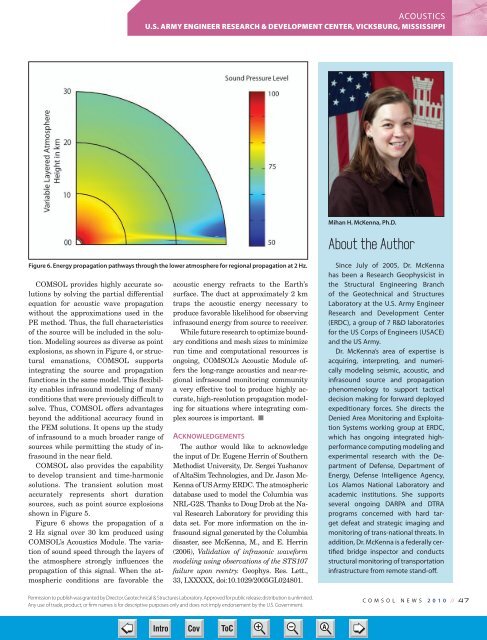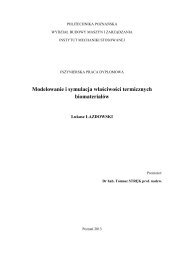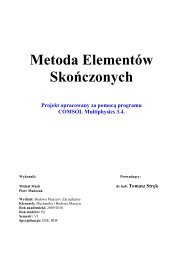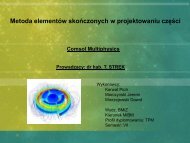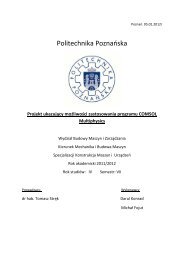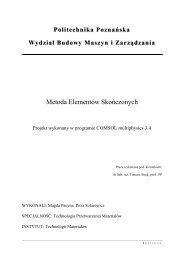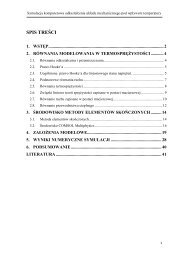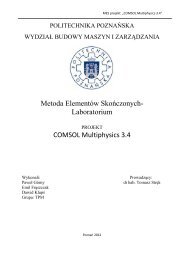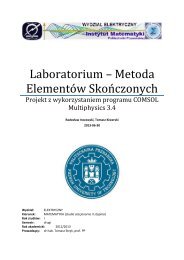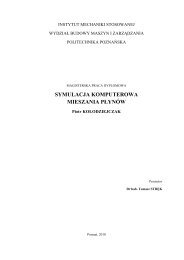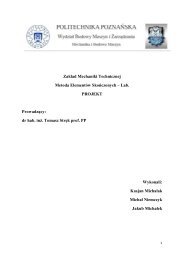comsol - tomasz strek home page
comsol - tomasz strek home page
comsol - tomasz strek home page
You also want an ePaper? Increase the reach of your titles
YUMPU automatically turns print PDFs into web optimized ePapers that Google loves.
ACOUSTICS<br />
U.S. ARMY ENGINEER RESEARCH & DEVELOPMENT CENTER, VICKSBURG, MISSISSIPPI<br />
Mihan H. McKenna, Ph.D.<br />
<br />
Figure 6. Energy propagation pathways through the lower atmosphere for regional propagation at 2 Hz.<br />
COMSOL provides highly accurate solutions<br />
by solving the partial differential<br />
equation for acoustic wave propagation<br />
without the approximations used in the<br />
PE method. Thus, the full characteristics<br />
of the source will be included in the solution.<br />
Modeling sources as diverse as point<br />
explosions, as shown in Figure 4, or structural<br />
emanations, COMSOL supports<br />
integrating the source and propagation<br />
functions in the same model. This flexibility<br />
enables infrasound modeling of many<br />
conditions that were previously difficult to<br />
solve. Thus, COMSOL offers advantages<br />
beyond the additional accuracy found in<br />
the FEM solutions. It opens up the study<br />
of infrasound to a much broader range of<br />
sources while permitting the study of infrasound<br />
in the near field.<br />
COMSOL also provides the capability<br />
to develop transient and time-harmonic<br />
solutions. The transient solution most<br />
accurately represents short duration<br />
sources, such as point source explosions<br />
shown in Figure 5.<br />
Figure 6 shows the propagation of a<br />
2 Hz signal over 30 km produced using<br />
COMSOL’s Acoustics Module. The variation<br />
of sound speed through the layers of<br />
the atmosphere strongly influences the<br />
propagation of this signal. When the atmospheric<br />
conditions are favorable the<br />
acoustic energy refracts to the Earth’s<br />
surface. The duct at approximately 2 km<br />
traps the acoustic energy necessary to<br />
produce favorable likelihood for observing<br />
infrasound energy from source to receiver.<br />
While future research to optimize boundary<br />
conditions and mesh sizes to minimize<br />
run time and computational resources is<br />
ongoing, COMSOL’s Acoustic Module offers<br />
the long-range acoustics and near-regional<br />
infrasound monitoring community<br />
a very effective tool to produce highly accurate,<br />
high-resolution propagation modeling<br />
for situations where integrating complex<br />
sources is important. <br />
ACKNOWLEDGEMENTS<br />
The author would like to acknowledge<br />
the input of Dr. Eugene Herrin of Southern<br />
Methodist University, Dr. Sergei Yushanov<br />
of AltaSim Technologies, and Dr. Jason Mc-<br />
Kenna of US Army ERDC. The atmospheric<br />
database used to model the Columbia was<br />
NRL-G2S. Thanks to Doug Drob at the Naval<br />
Research Laboratory for providing this<br />
data set. For more information on the infrasound<br />
signal generated by the Columbia<br />
disaster, see McKenna, M., and E. Herrin<br />
(2006), Validation of infrasonic waveform<br />
modeling using observations of the STS107<br />
failure upon reentry. Geophys. Res. Lett.,<br />
33, LXXXXX, doi:10.1029/2005GL024801.<br />
Since July of 2005, Dr. McKenna<br />
has been a Research Geophysicist in<br />
the Structural Engineering Branch<br />
of the Geotechnical and Structures<br />
Laboratory at the U.S. Army Engineer<br />
Research and Development Center<br />
(ERDC), a group of 7 R&D laboratories<br />
for the US Corps of Engineers (USACE)<br />
and the US Army.<br />
Dr. McKenna’s area of expertise is<br />
acquiring, interpreting, and numerically<br />
modeling seismic, acoustic, and<br />
infrasound source and propagation<br />
phenomenology to support tactical<br />
decision making for forward deployed<br />
expeditionary forces. She directs the<br />
Denied Area Monitoring and Exploitation<br />
Systems working group at ERDC,<br />
which has ongoing integrated highperformance<br />
computing modeling and<br />
experimental research with the Department<br />
of Defense, Department of<br />
Energy, Defense Intelligence Agency,<br />
Los Alamos National Laboratory and<br />
academic institutions. She supports<br />
several ongoing DARPA and DTRA<br />
programs concerned with hard target<br />
defeat and strategic imaging and<br />
monitoring of trans-national threats. In<br />
addition, Dr. McKenna is a federally certified<br />
bridge inspector and conducts<br />
structural monitoring of transportation<br />
infrastructure from remote stand-off.<br />
Permission to publish was granted by Director, Geotechnical & Structures Laboratory. Approved for public release; distribution is unlimited.<br />
Any use of trade, product, or firm names is for descriptive purposes only and does not imply endorsement by the U.S. Government.<br />
COMSOL NEWS 2010 //<br />
➮<br />
Intro<br />
Cov ToC + – A<br />
➭


